本文相关测试代码。
从数据库中读取枚举值
使用Mybatis-Plus读取
借助 MyBatis-Plus 可以很容易的实现这一点。
首先需要在配置文件中加入type-enums-package指定枚举的扫描包,**MyBatis-Plus** 将为包内(包含子包)所有枚举进行适配,可以使用逗号或封号分隔多个包名。
1
2
| mybatis-plus:
type-enums-package: [枚举包][,|;][枚举包]
|
接着在枚举类中指定数据库值所对应的属性。这里可以采用两种方式。
在类的属性声明上直接将字段类型标记为枚举类型,读取时将自动转换数据库值为枚举对象。
1
2
3
4
5
6
7
8
9
10
11
| @Data
@Accessors(chain = true)
@TableName("test")
public class TestDO {
private Integer id;
private String username;
private StatusEnum status;
}
|
读取数据库中的两条数据进行测试,可以看到值被成功转换为了枚举。

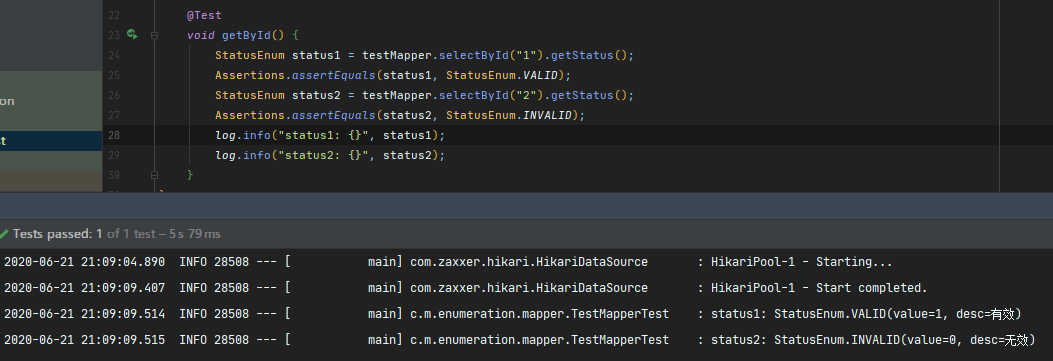
MyBatis-Plus的实现
从 MyBatis-Plus com.baomidou.mybatisplus.extension.spring.MybatisSqlSessionFactoryBean 中可以找到它是如何实现的。
在buildSqlSessionFactory方法中可以看到,在配置了type-enums-package的情况下, MyBatis-Plus 将为该包下满足处理条件的枚举注册MybatisEnumTypeHandler类型转换处理器
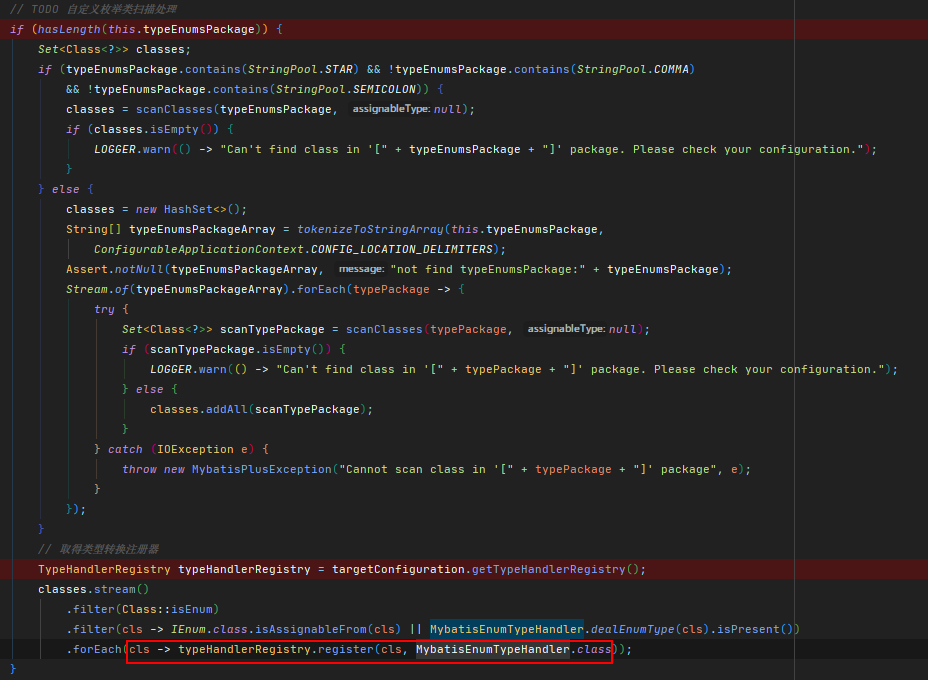
在MybatisEnumTypeHandler中将取出实现IEnum接口的枚举的getValue方法或使用 @EnumValue 标记的字段的getter方法进行数据库值处理。
使用Mybatis实现
Mybatis提供了default-enum-type-handler配置用于改写默认的枚举处理器,这里简单粗暴的直接替换了默认处理器( MyBatis-Plus 是满足条件的类才注册为该处理器处理,实际情况也应该如此)。
1
2
3
| mybatis:
configuration:
default-enum-type-handler: com.baomidou.mybatisplus.extension.handlers.MybatisEnumTypeHandler
|
同样,这样也能完成枚举映射。
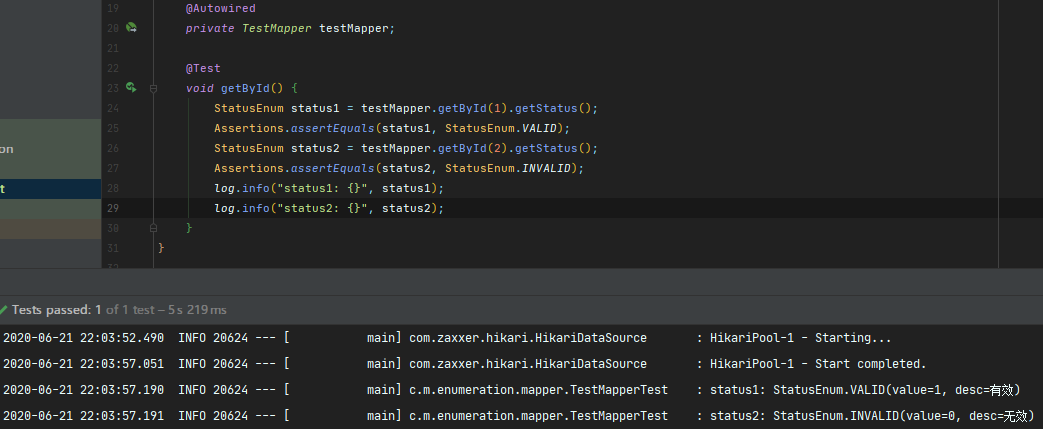
或者在原有的 Mybatis 配置下追加类似的处理器注册操作。
1
2
3
4
5
6
7
8
9
10
11
12
13
| @Configuration
public class MybatisConfig implements InitializingBean {
private final SqlSessionFactory sqlSessionFactory;
public MybatisConfig(SqlSessionFactory sqlSessionFactory) {
this.sqlSessionFactory = sqlSessionFactory;
}
@Override
public void afterPropertiesSet() throws Exception {
sqlSessionFactory.getConfiguration().getTypeHandlerRegistry().register(StatusEnum.class, MybatisEnumTypeHandler.class);
}
}
|
将请求值转换为枚举对象
虽然成功的将数据库值读为枚举属性,但如果不做处理,实体上的枚举类型将会成为累赘使请求值无法转换,因此需要处理使请求的字符串或数字值能够转换为枚举对象。
普通请求
对于诸如Get请求,Post表单请求的普通请求,可以使用自定义的转换器工厂进行处理,我们需要继承ConverterFactory类并指定想要处理的类型。
1
2
3
4
5
6
7
8
9
10
11
12
13
14
15
16
17
18
19
20
21
22
23
24
25
26
27
28
29
30
31
32
33
34
35
36
37
38
39
40
41
42
43
44
45
46
47
48
49
50
51
52
53
54
55
56
57
58
59
60
61
62
63
64
65
66
67
68
69
70
71
72
73
| @Slf4j
public class StringToEnumConverterFactory implements ConverterFactory<String, Enum<?>> {
private static final Map<Class<?>, Converter<String, ? extends Enum<?>>> CONVERTER_MAP = new ConcurrentHashMap<>();
private static final Map<Class<?>, Method> TABLE_METHOD_OF_ENUM_TYPES = new ConcurrentHashMap<>();
@Override
@SuppressWarnings("unchecked cast")
public <T extends Enum<?>> Converter<String, T> getConverter(Class<T> targetType) {
Converter<String, T> converter = (Converter<String, T>) CONVERTER_MAP.get(targetType);
if (converter == null) {
converter = new StringToEnumConverter<>(targetType);
CONVERTER_MAP.put(targetType, converter);
}
return converter;
}
static class StringToEnumConverter<T extends Enum<?>> implements Converter<String, T> {
private final Map<String, T> enumMap = new ConcurrentHashMap<>();
StringToEnumConverter(Class<T> enumType) {
Method method = getMethod(enumType);
T[] enums = enumType.getEnumConstants();
for (T e : enums) {
try {
enumMap.put(method.invoke(e).toString(), e);
} catch (IllegalAccessException | InvocationTargetException ex) {
log.error("获取枚举值错误!!! ", ex);
}
}
}
@Override
public T convert(@NotNull String source) {
T t = enumMap.get(source);
if (t == null) {
throw new IllegalArgumentException("该字符串找不到对应的枚举对象 字符串:" + source);
}
return t;
}
}
public static <T> Method getMethod(Class<T> enumType) {
Method method;
if (IEnum.class.isAssignableFrom(enumType)) {
try {
method = enumType.getMethod("getValue");
} catch (NoSuchMethodException e) {
throw new IllegalArgumentException(String.format("类:%s 找不到 getValue方法",
enumType.getName()));
}
} else {
method = TABLE_METHOD_OF_ENUM_TYPES.computeIfAbsent(enumType, k -> {
Field field =
dealEnumType(enumType).orElseThrow(() -> new IllegalArgumentException(String.format(
"类:%s 找不到 EnumValue注解", enumType.getName())));
return ReflectionKit.getMethod(enumType, field);
});
}
return method;
}
private static Optional<Field> dealEnumType(Class<?> clazz) {
return clazz.isEnum() ?
Arrays.stream(clazz.getDeclaredFields()).filter(field -> field.isAnnotationPresent(EnumValue.class)).findFirst() : Optional.empty();
}
}
|
要使自定义的转换器工厂生效,需要实现WebMvcConfigurer接口并在addFormatters方法中进行追加。
1
2
3
4
5
6
7
| @Configuration
public class ConverterFactoryConfig implements WebMvcConfigurer {
@Override
public void addFormatters(FormatterRegistry registry) {
registry.addConverterFactory(new StringToEnumConverterFactory());
}
}
|
转换器生效,请求中的字符串类型,如果发现需要转换为枚举,则会触发自定义的转换器,并转换为对应的枚举。
1
2
3
4
5
6
7
8
9
10
11
12
13
| @RestController
@RequestMapping("/test")
public class TestController{
@GetMapping
public String getEnum(StatusEnum status) {
return status.getDesc();
}
@PostMapping("post")
public String postEnum(StatusEnum status) {
return status.getDesc();
}
}
|
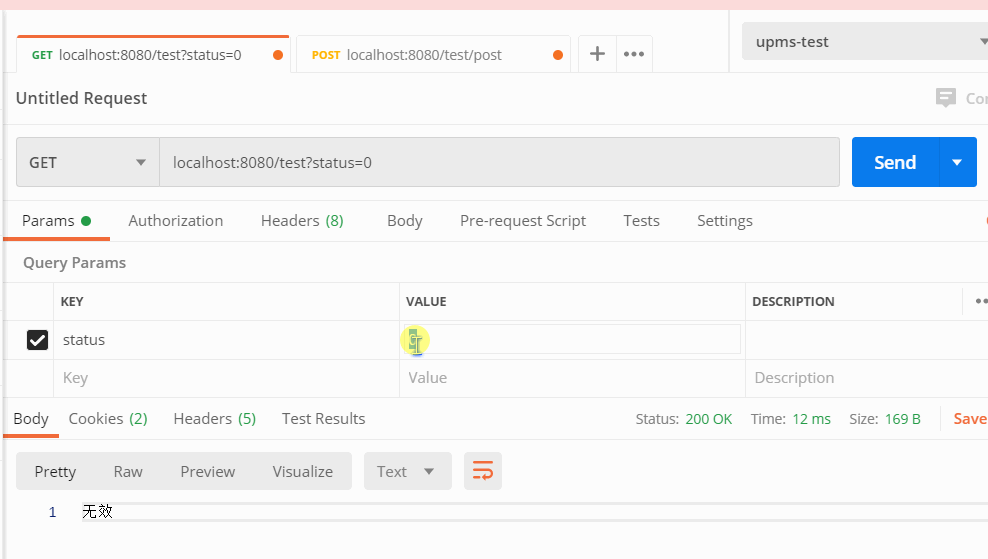
Json请求
Jackson
json请求使用 @RequestBody 注解标记接收,处理器为项目中指定的消息转换器。在 Springboot 中默认为 Jackson 。
Jackson对枚举的默认行为为按枚举名或其所在的位置(从0开始计算),例如当传入0时获取的是枚举类中的第一个对象。
这显然不是我们要的,使用 @JsonCreator 注解可以自定义枚举创建的方式。
增加枚举类方法:
1
2
3
4
5
6
7
8
9
| @JsonCreator
public static StatusEnum getItem(int code){
for(StatusEnum item : values()){
if(item.getValue() == code){
return item;
}
}
return null;
}
|
此时反序列化时将调用此方法创建枚举对象。
如果需要将转换的范围局限在某个实体字段,可以选择自定义JsonDeserializer。
1
2
3
4
5
6
7
8
9
10
11
12
13
| @Slf4j
public class JacksonStatusEnumDeserializer extends JsonDeserializer<StatusEnum> {
@Override
public StatusEnum deserialize(JsonParser jsonParser, DeserializationContext deserializationContext) throws IOException {
String text = jsonParser.getText();
for (StatusEnum value : StatusEnum.values()) {
if (Objects.equals(text, value.getValue().toString())) {
return value;
}
}
return null;
}
}
|
然后在实体字段上使用注解注明反序列化器。
1
2
| @JsonDeserialize(using = JacksonStatusEnumConverter.class)
private StatusEnum status;
|
由于在JsonDeserializer中DeserializationContext无法获取到实际的类信息,这意味着单独使用JsonDeserializer无法作为枚举的通用解决方案,我们必须为每一个枚举类定制一个反序列化处理方案。
要实现通用的解决方案,需要实现ContextualDeserializer辅助获取转换时的类信息(createContextual每个枚举类只会触发一次,之后都使用该方法返回的反序列化器处理)。
1
2
3
4
5
6
7
8
9
10
11
12
13
14
15
16
17
18
19
20
21
22
23
24
25
26
27
28
29
30
31
32
33
34
35
36
37
38
39
40
41
42
| @Slf4j
@Setter
public class JacksonEnumDeserializer extends JsonDeserializer<Enum<?>> implements ContextualDeserializer {
private Class<?> clazz;
@Override
public Enum<?> deserialize(JsonParser jsonParser, DeserializationContext ctx) throws IOException, JsonProcessingException {
Class<?> enumType = clazz;
if (Objects.isNull(enumType) || !enumType.isEnum()) {
return null;
}
String text = jsonParser.getText();
Method method = StringToEnumConverterFactory.getMethod(clazz);
Enum<?>[] enumConstants = (Enum<?>[]) enumType.getEnumConstants();
for (Enum<?> e : enumConstants) {
try {
if (Objects.equals(method.invoke(e).toString(), text)) {
return e;
}
} catch (IllegalAccessException | InvocationTargetException ex) {
log.error("获取枚举值错误!!! ", ex);
}
}
return null;
}
@Override
public JsonDeserializer<Enum<?>> createContextual(DeserializationContext ctx, BeanProperty property) throws JsonMappingException {
Class<?> rawCls = ctx.getContextualType().getRawClass();
JacksonEnumDeserializer converter = new JacksonEnumDeserializer();
converter.setClazz(rawCls);
return converter;
}
}
|
使用此序列化器备注的字段将能够被正确处理。
如果需要更大范围的采用此序列化器,将所有的枚举类型默认都委托给JacksonEnumConverter处理,可以修改默认的HttpMessageConverter。
1
2
3
4
5
6
7
8
9
10
| @Configuration
public class JacksonConfig {
@Bean
public HttpMessageConverter<?> httpMessageConverter(ObjectMapper objectMapper) {
SimpleModule simpleModule = new SimpleModule();
simpleModule.addDeserializer(Enum.class, new JacksonEnumConverter());
objectMapper.registerModule(simpleModule);
return new MappingJackson2HttpMessageConverter(objectMapper);
}
}
|
或者在JacksonEnumConverter上使用**@JsonComponent**注解标记。
1
2
| @JsonComponent
public class JacksonEnumDeserializer extends JsonDeserializer<Enum<?>> implements ContextualDeserializer
|
此时所有的枚举类型都将委托给该反序列化器处理。
FastJson
FastJson对枚举的默认行为同样为按枚举名或其所在的位置(从0开始计算),唯一不同的地方在于它强制要求按位置计算则需要传入的类型为数字类型(即不使用””包裹)。例如:
1
2
3
| {
"fastJsonStatusEnum": 1
}
|
FastJson同样支持为枚举指定反序列化方式。
反序列化器需要实现ObjectDeserializer接口。
1
2
3
4
5
6
7
8
9
10
11
12
13
14
15
16
17
18
19
20
21
22
23
24
25
26
27
28
29
30
31
| @Slf4j
public class FastJsonEnumDeserializer implements ObjectDeserializer
{
@Override
public <T> T deserialze(DefaultJSONParser parser, Type type, Object o) {
final JSONLexer lexer = parser.lexer;
Class<?> cls = (Class<?>) type;
Object[] enumConstants = cls.getEnumConstants();
Method method = StringToEnumConverterFactory.getMethod(cls);
if (!Enum.class.isAssignableFrom(cls)) {
return null;
}
for (Object item : enumConstants) {
try {
String value = method.invoke(item).toString();
if (Objects.equals(value, lexer.stringVal()) || Objects.equals(Integer.valueOf(value), lexer.intValue())) {
return (T)item;
}
} catch (IllegalAccessException | InvocationTargetException ex) {
log.error("获取枚举值错误!!! ", ex);
}
}
return null;
}
@Override
public int getFastMatchToken() {
return JSONToken.LITERAL_INT;
}
}
|
在枚举类上增加JSONType即可指定反序列化方式。
1
| @JSONType(deserializer = FastJsonEnumDeserializer.class)
|
反序列化器同样可以借助**@JSONField**注解使其仅在实体字段生效。
1
| @JSONField(deserializeUsing = FastJsonEnumDeserializer.class)
|
通过修改ParserConfig配置可以修改指定类的反序列化器,但由于 FastJson 获取序列化器时是直接从deserializers链表中直接按类型读取,并未做根类型的特殊处理,这意味着我们无法通过Enum类的配置覆盖所有枚举类,需要自行扫描所有枚举并加入配置,示例中借助hutool扫描指定包下的类。
1
2
3
4
| <dependency>
<groupId>cn.hutool</groupId>
<artifactId>hutool-all</artifactId>
</dependency>
|
1
2
3
4
5
6
7
8
9
10
11
12
13
14
15
| @Configuration
public class FastJsonConfig {
private static final String ENUM_BASE_PKG = "com.maple.enumeration.enums";
@Bean
public HttpMessageConverter<?> httpMessageConverter() {
FastJsonHttpMessageConverter fastConverter = new FastJsonHttpMessageConverter();
ParserConfig parserConfig = fastConverter.getFastJsonConfig().getParserConfig();
ClassUtil.scanPackage(ENUM_BASE_PKG).stream().filter(Class::isEnum).forEach(item ->
parserConfig.putDeserializer(item, new FastJsonEnumDeserializer()));
return fastConverter;
}
}
|
将枚举对象序列化为字符串
搞定了反序列化后,需要处理的便是序列化操作了。
Jackson
Jackson支持三个序列化枚举的SerializationFeature配置。
1
2
3
4
5
6
| // 直接根据toString方法的返回值序列化
SerializationFeature.WRITE_ENUMS_USING_TO_STRING
// 写出枚举序号
SerializationFeature.WRITE_ENUMS_USING_INDEX
// 写出枚举名 默认
SerializationFeature.WRITE_ENUM_KEYS_USING_INDEX
|
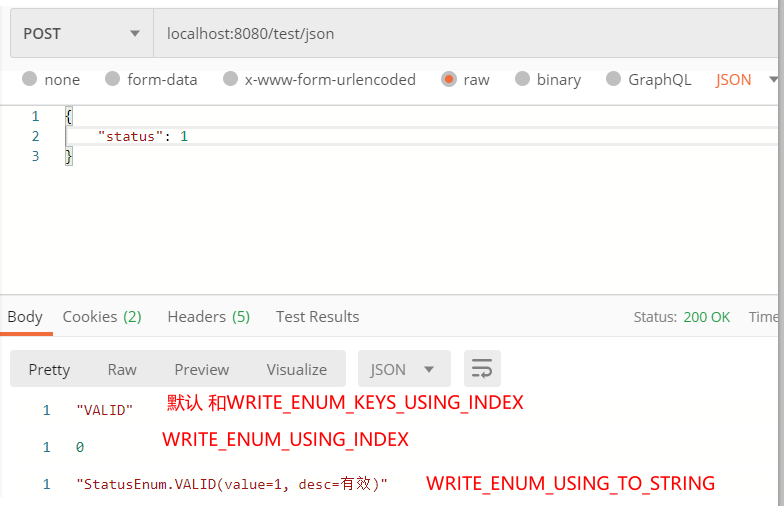
配置文件配置:
1
2
3
4
5
6
| spring:
jackson:
serialization:
WRITE_ENUMS_USING_TO_STRING: true
|
或者通过Bean配置:
1
2
3
4
5
6
7
| @Configuration
public class JacksonConfig {
@Bean
public Jackson2ObjectMapperBuilderCustomizer customizer() {
return builder -> builder.featuresToEnable(SerializationFeature.WRITE_ENUMS_USING_TO_STRING);
}
}
|
若配置不满足需求,还可以使用 @JsonValue 注解标记需要序列化返回的值(同一个类中不允许多个标记,标记字段则取字段实际值,标记方法则取方法返回值)。
1
2
| @JsonValue
private final String desc;
|
使用 @JsonFormat(shape = JsonFormat.Shape.OBJECT) 标记枚举类可以使枚举被序列化为对象形式。

同样我们也可以通过继承JsonSerializer实现一个限定范围的序列化器,这里实现了序列化为对象形式的敷衍版本(工具类来自hutool)。
1
2
3
4
5
6
7
8
9
10
11
12
13
14
15
16
17
18
19
20
21
22
23
24
25
26
27
28
29
30
31
|
@JsonSerialize(using = JacksonEnumSerializer.class)
private StatusEnum status;
@Slf4j
public class JacksonEnumSerializer extends JsonSerializer<Enum<?>> {
@Override
public void serialize(Enum<?> value, JsonGenerator gen, SerializerProvider serializers) throws IOException {
Method[] methods = ReflectUtil.getMethods(value.getClass(), item -> StrUtil.startWith(item.getName(), "get"));
gen.writeStartObject();
for (Method method : methods) {
String name = StrUtil.subAfter(method.getName(), "get", false);
name = name.substring(0, 1).toLowerCase() + name.substring(1);
String invokeStr = Objects.toString(ReflectUtil.invoke(value, method));
if (!NumberUtil.isNumber(invokeStr)) {
gen.writeStringField(name, invokeStr);
continue;
}
if (invokeStr.contains(".")) {
gen.writeNumberField(name, Double.parseDouble(invokeStr));
continue;
}
gen.writeNumberField(name, Long.parseLong(invokeStr));
}
gen.writeEndObject();
}
}
|
将序列化器全局化:
1
2
3
4
5
6
7
8
9
10
11
12
13
| @JsonComponent
public class JacksonEnumSerializer extends JsonSerializer<Enum<?>>
// 或者bean配置
@Configuration
public class JacksonConfig {
@Bean
public HttpMessageConverter<?> httpMessageConverter(ObjectMapper objectMapper) {
SimpleModule simpleModule = new SimpleModule();
simpleModule.addSerializer(Enum.class, new JacksonEnumSerializer());
objectMapper.registerModule(simpleModule);
return new MappingJackson2HttpMessageConverter(objectMapper);
}
}
|
我们也可以将 @JsonFormat(shape = JsonFormat.Shape.OBJECT) 全局化,但此方式只支持到具体类,因此如果有需要也只能通过包扫描的形式进行进行全局定义。
1
2
3
4
5
6
7
8
9
10
11
| @Configuration
public class JacksonConfig {
private static final String ENUM_BASE_PKG = "com.maple.enumeration.enums";
@Bean
public HttpMessageConverter<?> httpMessageConverter(ObjectMapper objectMapper) {
ClassUtil.scanPackage(ENUM_BASE_PKG).forEach(item -> objectMapper.configOverride(item)
.setFormat(JsonFormat.Value.forShape(JsonFormat.Shape.OBJECT)));
return new MappingJackson2HttpMessageConverter(objectMapper);
}
}
|
附:各种场景的序列化优先级:
实体字段上的 @JsonSerialize配置 > 枚举上的 @JsonSerialize配置 > 全局JsonSerializer注册 > 枚举上的 @JsonValue配置 > 实体字段的 @JsonFormat配置> 全局的configOverride配置覆盖 > 枚举上的 @JsonFormat配置
FastJson
Jackson支持两个序列化枚举的SerializationFeature配置。
1
2
3
4
| // 直接根据toString方法的返回值序列化
SerializerFeature.WriteEnumUsingToString
// 默认 根据枚举名序列化
SerializerFeature.WriteEnumUsingName
|
bean配置:
1
2
3
4
5
6
| @Bean
public HttpMessageConverter<?> httpMessageConverter() {
FastJsonHttpMessageConverter fastConverter = new FastJsonHttpMessageConverter();
fastConverter.getFastJsonConfig().setSerializerFeatures(SerializerFeature.WriteEnumUsingToString);
return fastConverter;
}
|
实现一个类似的序列化为对象的序列化器(还是敷衍版)。
1
2
3
4
5
6
7
8
9
10
11
12
13
14
15
| @Slf4j
public class FastJsonEnumSerializer implements ObjectSerializer {
@Override
public void write(JSONSerializer serializer, Object object, Object fieldName, Type fieldType, int features) throws IOException {
Method[] methods = ReflectUtil.getMethods(object.getClass(), item -> StrUtil.startWith(item.getName(), "get"));
Map<String, Object> objectMap = new HashMap<>(methods.length);
for (Method method : methods) {
String name = StrUtil.subAfter(method.getName(), "get", false);
name = name.substring(0, 1).toLowerCase() + name.substring(1);
objectMap.put(name, ReflectUtil.invoke(object, method));
}
serializer.write(objectMap);
}
}
|
可以在类上使用 @JSONType注解标记或在类字段用 @JSONField标记。
1
2
3
4
5
| @JSONField(serializeUsing = FastJsonEnumSerializer.class)
private FastJsonStatusEnum fastJsonStatusEnum;
@JSONType(serializer = FastJsonEnumSerializer.class)
public enum FastJsonStatusEnum
|
配置为全局生效同样需要自行扫描添加。
1
2
3
4
5
6
7
8
| @Bean
public HttpMessageConverter<?> httpMessageConverter() {
FastJsonHttpMessageConverter fastConverter = new FastJsonHttpMessageConverter();
ClassUtil.scanPackage(ENUM_BASE_PKG).stream().filter(Class::isEnum).forEach(item ->
fastConverter.getFastJsonConfig().getSerializeConfig().put(FastJsonStatusEnum.class,
new FastJsonEnumSerializer()));
return fastConverter;
}
|
附:各种场景的序列化优先级:
实体字段上的 @JSONField配置 > 全局SerializeConfig配置 > 枚举上的 @JSONType配置






